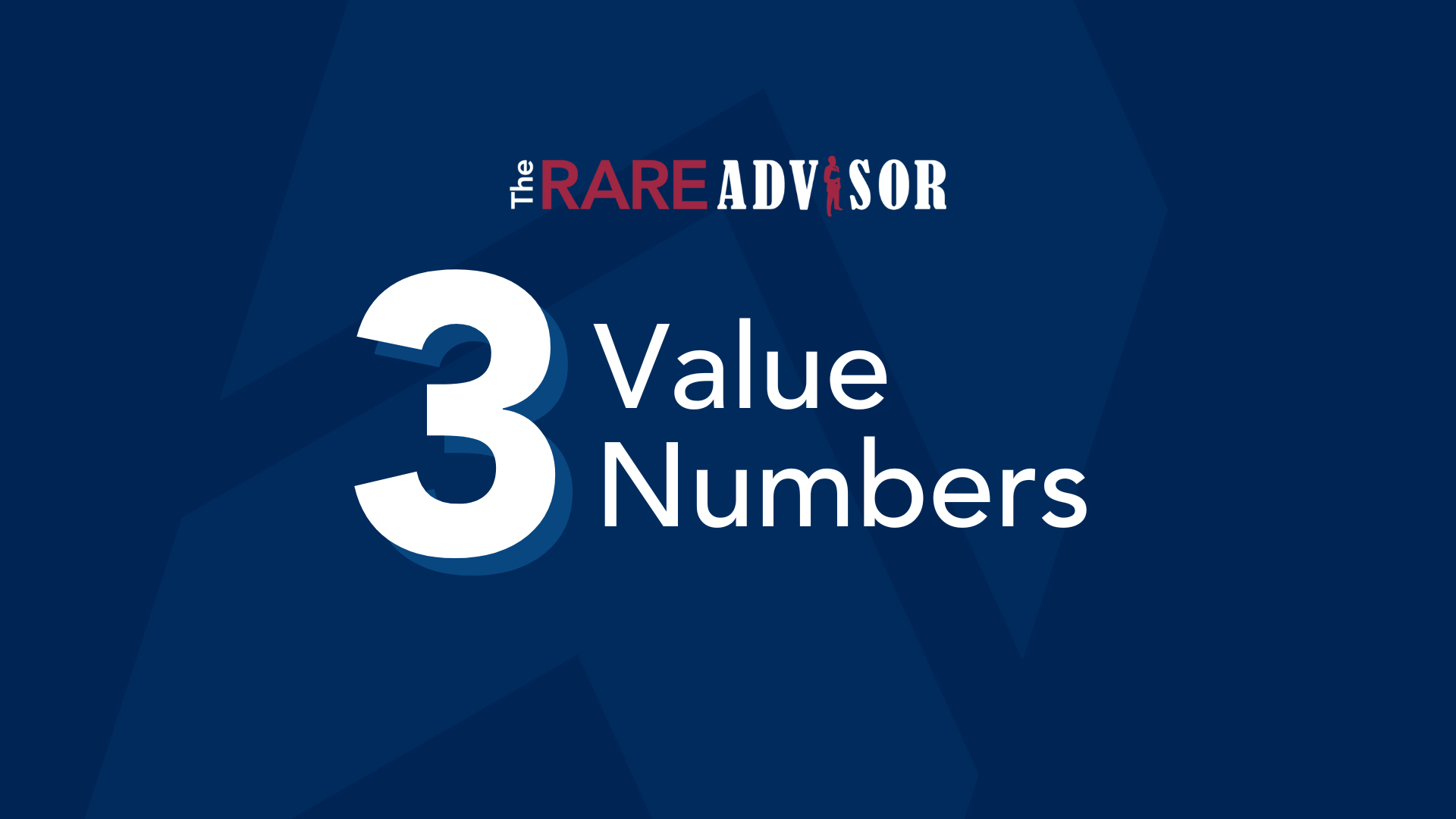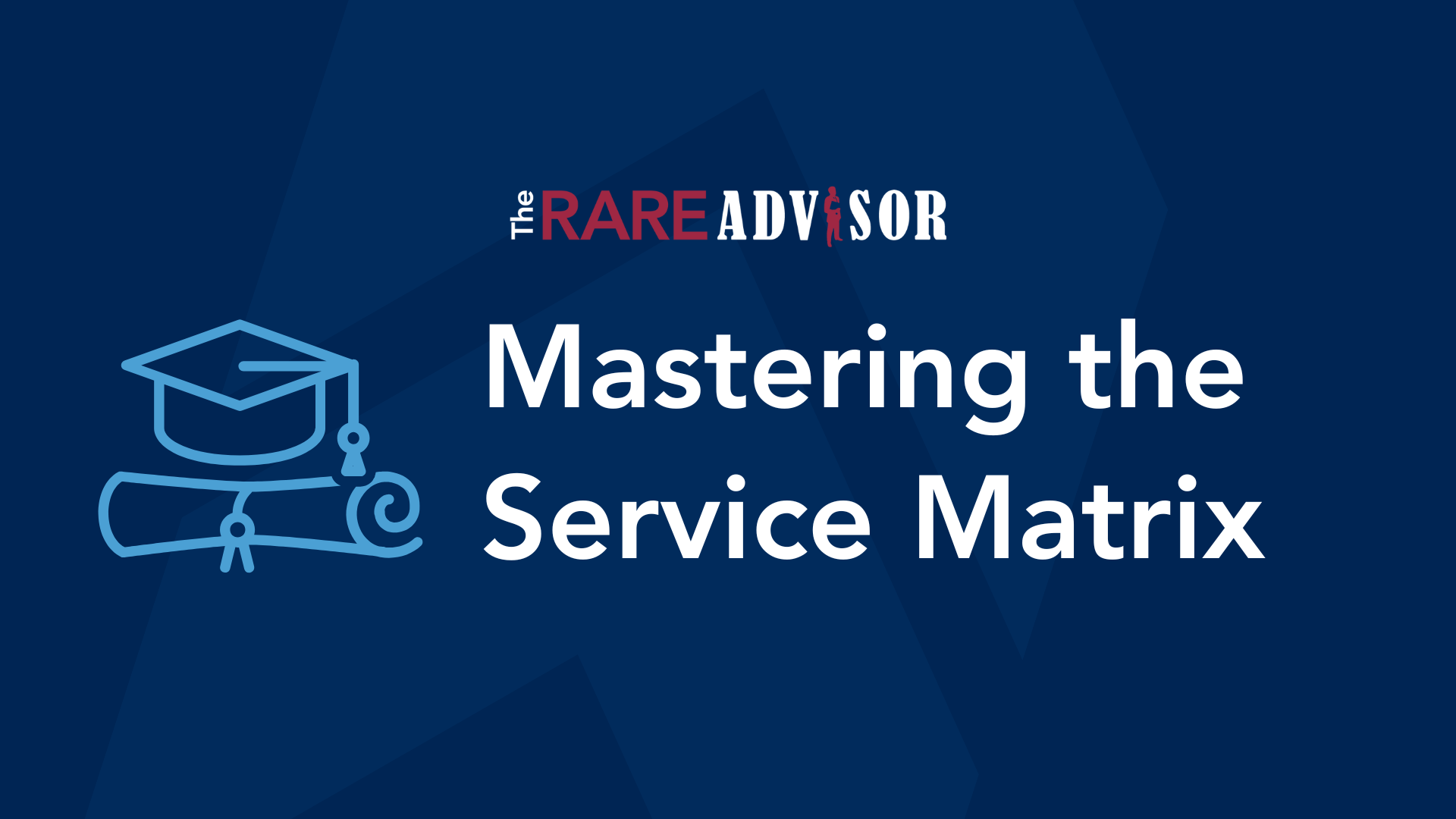The RARE Advisor: The 3 Value Numbers You Need to Know

In this episode of The RARE Advisor, we’re going to take the highly complex subject of valuation and business appraisals and boil it down into just three numbers you need to know.
The world of valuation for your practice can be mind-boggling. And it's important that you understand it because it's not just about the valuation in case you want to transition, retire, create a succession plan, or just outright sell. It's also important because it's the equivalent of your stock price. It's what identifies whether or not you're actually growing, maintaining, or retracting. So, it's really important and a lot of people get confused or overwhelmed by it all - and you don't really need to. I mean, I can talk to you for days about all the intricacies of deals and structure, and different ways to bring your next gen advisors in, and then overlaying it with phantom stock, and a host of other things that we can help you with. But really, to wrap your mind around it, you just need to understand three numbers in order to get your arms around the worth of your practice, or in this example, the worth of your assets under management. Those three numbers are 2.7, 27%, and 10.
The recurring revenue valuation multiple, if you're going off of a valuation of revenue, is 2.7 right now. EBITDA (earnings before interest, taxes, depreciation, and amortization), as a target for financial services, is 27% - it means you should be able to get or retain 27% down to the bottom line. So basically, your net profit. I should be able to get 27% from what I bring in down to the bottom. Now, if you're running a smaller practice, and you're saying, "Well, first of all, I don't even know what EBITDA is. And secondly, I don't have any." Well, you really do. The difference is, you're probably extracting everything out in terms of your income - you get to the end of a quarter or the end of the year, you see how much dollars that you have inside of the practice, and that's what you pull out to live on. Now, what you can do is you can normalize it. You can do add backs, you can figure out what revenue you would pay to replace yourself. What would you pay someone to do your job if you weren't the one doing it? You'd probably pay them less than you're paying yourself. And theoretically, by making that adjustment, you should (if you're running a good practice) be getting 27% down to that EBITDA line. And then we look at EBITDA multiples, which are different than revenue multiples. The revenue multiple is 2.7. The EBITDA multiple is 10.
So that 27% I get to the bottom line, if I multiply that by 10, or if I take my top line number and I multiply it by 2.7, I should get the same number - because it doesn't really matter how you're being valued. There are different valuation methods, but they're there to kind of double check each other, there to make sure that there aren't any weird fluctuations, that one assessment provides a view into that maybe another assessment somehow glossed over. But the reality is, if you're running a clean, normal, all things being equal type of practice, you should get the same number either way.
So, here's an example. If I've got $1 million of EBITDA, and it represents 27% of my overall revenue, then that means my gross revenue is a hair over $3.7 million. So in other words, if I've got $1 million dollars of EBITDA, divide that by 27%, which is that EBITDA benchmark, I'm gonna get $3,703,703. So a hair over 3.7 million. If I take that number, and I multiply it by 2.7, it equals $10 million. If I take $1 million dollars of EBITDA, and I multiply it by 10, what does that equal? $10 million. I get the same answer each way. The three things you need to understand is: 2.7 is the multiple for recurring revenue, 27% is how much EBITDA I should have, and 10 is the multiple on EBITDA. And there you have it.
--
The RARE Advisor is a business model supercharged by Recurring And Repeatable Events. With more than thirty years of working with and coaching successful advisors, host Mike Walters (along with other leaders in the industry), discusses what it takes to grow a successful practice. With the aim of helping financial professionals and financial advisors take their business to the next level, Mike Walters shares insights and success stories that make a real impact. Regardless of the stage of your practice, The RARE Advisor will provide thoughtful guidance, suggestions for developing systems and processes that work, and ideas for creating an authentic experience for your clients.
The RARE Advisor is also a podcast! Subscribe today via Apple Podcasts, Google Podcasts, or your preferred podcast listening service for easier on-the-go listening.
Author Info

Mike Walters is the Chief Executive Officer (CEO) of USA Financial, leading the firm since its inception in 1988. Mike is committed to...
Related Posts

Behavioral Finance, Simplified: 5 Biases Advisors Must Use in Their Marketing
In this episode of Financial Advisor’s Marketing Playbook, host Mark Mersman breaks down five core behavioral biases—loss aversion, status quo bias, anchoring, choice overload, and social proof—and shows how each can be translated into clear, compliant marketing messages that resonate with real human decision-making. You’ll learn how to reduce cognitive load, make emotion visible, eliminate friction, and set deliberate anchors in your website copy, emails, seminars, and first meetings. If you want your marketing to reflect how clients actually think and choose advisors, this practical framework will help you shift from a purely logical approach to one that validates emotions first—and earns trust that clients can later justify with facts.

Mastering the Service Matrix: Elevate Client Experience & Drive Advocacy
In this episode of The Rare Advisor, Aaron Grady and Allan Oehrlein dive deep into two essential tools for modern advisory practices: the service matrix and the stewardship framework. Discover why moving from a reactive to a proactive service model is critical for consistency, scalability, and client advocacy. Learn how these frameworks help advisors deliver predictable, high-touch experiences, segment clients effectively, and create professional contrast that sets your firm apart. If you want to elevate your client experience and build loyalty that lasts, this conversation is packed with actionable insights.

Year-End Planning with Purpose: Becoming the Advisor of the Future
In this episode of The RARE Advisor, Aaron Grady and Duncan MacPherson explore how financial advisors can approach year-end planning with intention and purpose. Rather than focusing solely on metrics and spreadsheets, they discuss the importance of aligning your “why” with your process and practice. Drawing on Japanese philosophies like Ikigai, Kaizen, Kintsugi, and Wabi Sabi, they share insights on creating a more meaningful, resilient, and sustainable business. Learn how embracing continuous improvement, authenticity, and technology can help you become the advisor of the future.

Behavioral Finance, Simplified: 5 Biases Advisors Must Use in Their Marketing
In this episode of Financial Advisor’s Marketing Playbook, host Mark Mersman breaks down five core behavioral biases—loss aversion, status quo bias, anchoring, choice overload, and social proof—and shows how each can be translated into clear, compliant marketing messages that resonate with real human decision-making. You’ll learn how to reduce cognitive load, make emotion visible, eliminate friction, and set deliberate anchors in your website copy, emails, seminars, and first meetings. If you want your marketing to reflect how clients actually think and choose advisors, this practical framework will help you shift from a purely logical approach to one that validates emotions first—and earns trust that clients can later justify with facts.

Mastering the Service Matrix: Elevate Client Experience & Drive Advocacy
In this episode of The Rare Advisor, Aaron Grady and Allan Oehrlein dive deep into two essential tools for modern advisory practices: the service matrix and the stewardship framework. Discover why moving from a reactive to a proactive service model is critical for consistency, scalability, and client advocacy. Learn how these frameworks help advisors deliver predictable, high-touch experiences, segment clients effectively, and create professional contrast that sets your firm apart. If you want to elevate your client experience and build loyalty that lasts, this conversation is packed with actionable insights.

Year-End Planning with Purpose: Becoming the Advisor of the Future
In this episode of The RARE Advisor, Aaron Grady and Duncan MacPherson explore how financial advisors can approach year-end planning with intention and purpose. Rather than focusing solely on metrics and spreadsheets, they discuss the importance of aligning your “why” with your process and practice. Drawing on Japanese philosophies like Ikigai, Kaizen, Kintsugi, and Wabi Sabi, they share insights on creating a more meaningful, resilient, and sustainable business. Learn how embracing continuous improvement, authenticity, and technology can help you become the advisor of the future.

